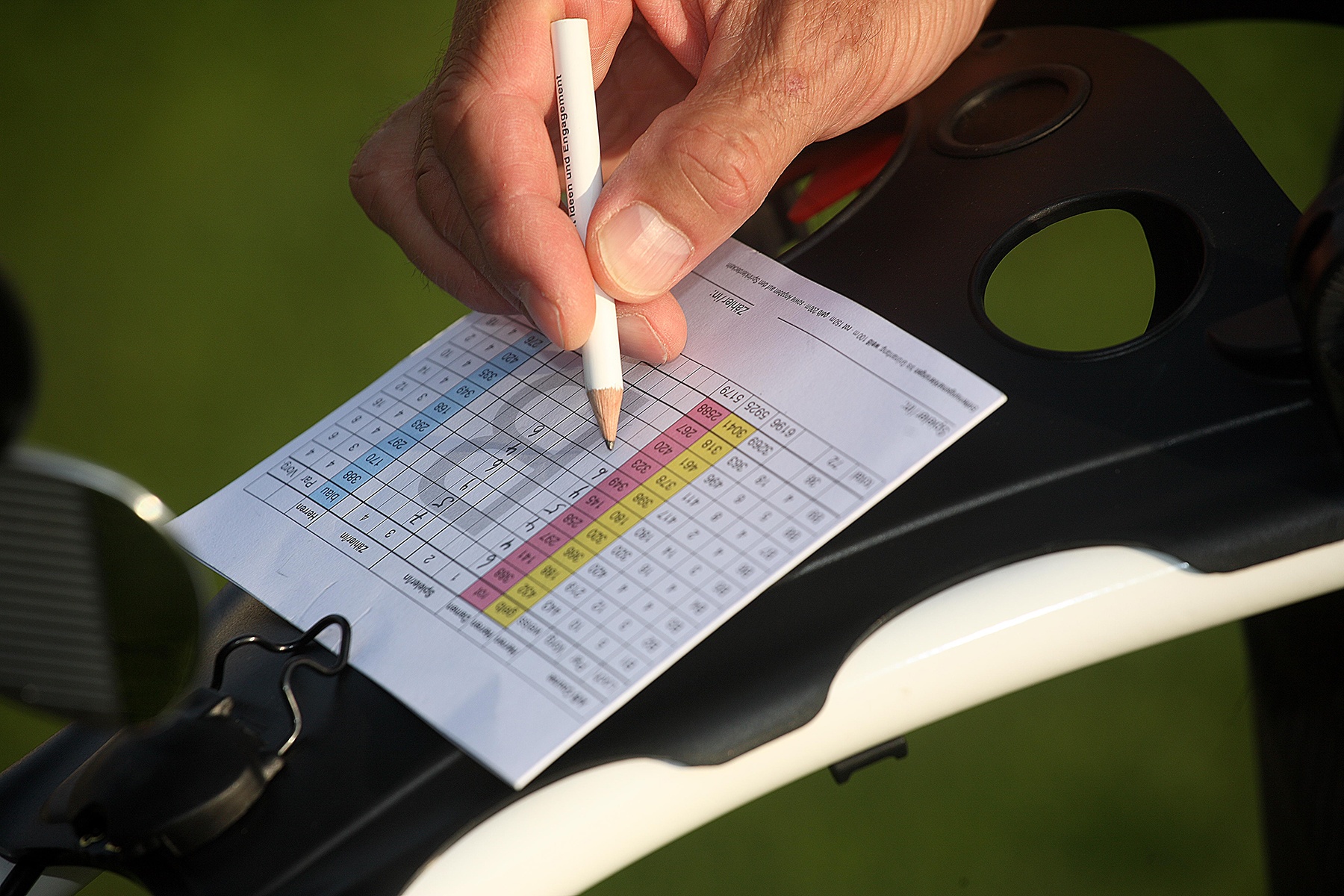The World Handicap Index (WHI) is a globally standardized handicap system for golf. It was introduced from the 2020 season and replaces the previous national handicap values, such as those used by the German Golf Association (DGV). Here is the most important information about the WHI.
The World Handicap Index (WHI)
The handicap describes the playing strength of a golfer. In future, this playing strength will be expressed by the World Handicap Index (WHI).
How is the World Handicap Index calculated?

The WHI is calculated from the average of the best eight scores from the last twenty handicap rounds. These can be handicap tournaments or EDS rounds. If a player has fewer results, a smaller number is used to determine the WHI. Results that are a maximum of 3 years old are taken into account. However, no final decision has yet been made on the maximum time horizon.
What happens if a player has not yet played 20 handicap rounds?
If a player has no results in his master sheet, the previous DGV handicap will also be his future WHI. (More on the official page)
A current handicap of e.g. 32.5 then becomes a handicap index of 32.5.
For long-time golfers
How is the difference score calculated, how do I determine the best 8 results and what does my new handicap index ultimately look like?
The formula for the difference score is: (score – course rating) *113 / slope rating
Subtract the CR value of the golf course you played from your game result (maximum score), multiply the result by the standard slope value of 113 and then divide the value by the slope rating.
Example: Score: 95 | CR value: 71.9 | Slope Rating: 128
(95 – 71,9) * 113 / 128 = 20,393
The calculated results are rounded to one decimal place. In our example, this would result in a difference score of 20.4. Now compare the last 20 difference scores with each other and select the best 8 results. Add these 8 results together and divide the result by 8 to obtain your new handicap index.
Example: Your best 8 results were: 20.4 / 22.1 / 20.9 / 25.7 / 26.3 / 19.9 / 23.4 / 20.5
->Total: 179.2 / 8 = 22.4 HCI (Handicap Index)
From the 2020 season, there will be a globally standardized golf handicap system(Official Site of the World Handicap System). This was announced by the R&A in a press release. It is very similar to the HC system of the USGA.
A minimum number of scores is required to obtain a new handicap. The recommendation is that the number of scores should be 54 holes from any combination of 18-hole and 9-hole rounds, but with some discretion given to national or regional associations to set a different minimum within their own jurisdiction.
- A consistent handicap that is transferable from course to course and country to country. This is based on the USGA Course and Slope Rating System, which is already used successfully in more than 80 countries.
- A calculation of the handicap on an average basis, which is determined from the best eight of the last 20 scores.
- A handicap calculation that takes into account outliers that abnormal course and weather conditions can have on a player’s performance on any given day.
- Daily handicap adjustments taking into account course and weather conditions
- A limit on the maximum hole value for net double bogey (for handicap purposes only).
- A maximum handicap of 54, regardless of gender, to encourage more golfers to measure and monitor their performance
measure and monitor their performance to make the game more enjoyable. - The DGV /ÖGV will discuss the introduction of the specific regulations applicable to German golfers from 2021 in
in due course, similar to the introduction of the new Rules of Golf in 2019. However, the DGV
recommends using the 2019 and 2020 seasons to offer golfers as many handicap-based competition formats and EDS rounds as possible before these changes take effect. - The question of why the local governing bodies are delaying the introduction of these changes by at least a year is not clear to me. Are they somehow trying to find a loophole here in order to maintain the power of the associations? As the umbrella associations are independent, the other global associations had to allow individual associations to make their own changes.
- The introduction on January 1, 2020 should take place immediately, without tactical delays. Or do the federations not trust their golfers to understand the new, simpler and then globally definitive system?
Important rule changes are:

- Ball search time only 3 minutes
- Step on ball in higher grass – put back without penalty
- Ball drilled into the ground – put back without penalty
- Measuring club lengths, the longest club may be taken, except putter
- Dropping from knee height
- Dropping no longer on the wrong green
- Hitting equipment/body is unpunishable if it is accidental
- Sticking on a shot without intention, unpunished
- Leveling tracks in the bunker, supporting the club is permitted
- Leaves, twigs or branches in obstacles may be removed, including bunkers or red. Ball must not be moved, otherwise a penalty stroke
- Ball in bunker unplayable, now ball behind bunker possible with two penalty strokes
- Water hazards are now called penaltyaeras. The club may now be placed on the ground
- Ball on green is moved by wind, must be put back
- Moving the ball on the green is penalty-free, e.g. by unintentional movement
- All damage may be repaired on the green, including pitch marks
- Placing the club on the ground to determine the direction is no longer permitted, especially for professionals
- Caddies (especially pros) are no longer allowed to stand behind the player to determine direction
- Hitting the flag is not penalized, i.e. it may always remain stuck.
- The ball is considered to be holed as soon as it is below the edge of the hole.
Terms relating to the World Handicap System
Soft Cap
The soft cap procedure comes into effect when the difference between a player’s calculated handicap index and his low handicap index is more than 3 strokes.
Hard cap
The hard cap procedure comes into effect to limit the increase in the handicap index to a total of no more than 5 strokes above the low handicap index after the soft cap procedure has been applied. There is no limit to how far a player’s Handicap Index can fall. Soft cap and hard cap are only taken into account if a low handicap index has been set
Course Handicap
In the handicap calculation, a course handicap is used to determine the number of strokes a player receives (or is granted) on any given golf course. In addition, the net par and net double bogey adjustments are determined against the course handicap.
Playing Handicap
The calculation of the playing handicap determines the number of strokes each player receives (or is granted) for the tournament ranking. These can be handicaps in four-ball competitions or hole games, for example.
Example of course or playing handicap:
If the majority of players play from a tee with the higher par, a handicap stroke can be deducted from the players who play from the tees with the lower par. Example: A lady and a gentleman both have a handicap index of 10.0. They play from different tees and the result is the playing handicap: Lady: Par 73 / CR 72.0 / Slope 113 = Playing Handicap 9 Gentleman: Par 72 / CR 72.0 / Slope 113 = Playing Handicap 10 The courses are equally difficult, only the par (not a measure of difficulty) differs. Both play a gross score of 80. The net results are as follows: Lady: Net 71 Gentleman: Net 70
Plus-Playing Handicapper
Unless otherwise stipulated by the management, players who are designated as plus playing handicappers (note = handicap index with – sign) give strokes in the competition, starting on the hole with the handicap distribution 18. For example, a player with a playing handicap of 2 gives one stroke on each of the holes with the handicap distribution 18 and 17.
Plus playing handicapper
Unless otherwise stipulated by the match management, players who are designated as plus playing handicappers (note = handicap index with – sign) give strokes in the competition, starting on the hole with the handicap distribution 18. For example, a player with a playing handicap of 2 gives one stroke on each of the holes with the handicap distribution 18 and 17.
With this in mind, I wish all golfers a good game for the rest of this season and a rosy outlook with regard to the prospect of a uniform handicap system.






